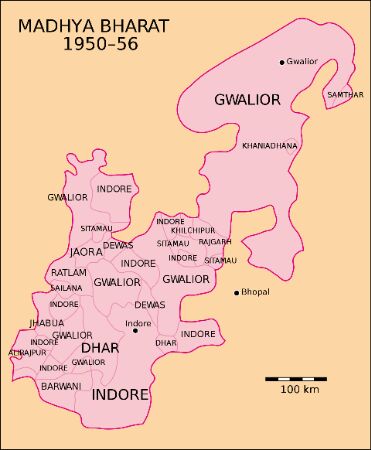Rivals in a union
Indore and Gwalior conceded, rather reluctantly, to merge into a single union despite having a hostile history towards each other

Madhya Bharat (Union of Gwalior, Indore and Malwa) was the largest part-B state comprising an area of 47,000 square miles, a population of seven million and revenue of Rs 8 crore. It had been formed after federating twenty-five states of Central India, and except for a small portion, the entire region was part of the Malwa plateau. However, getting the two leading states — Gwalior (a 21-gun salute state) and Indore (a 19-gun salute state) — with a history of hostility of over two centuries was a herculean task. Gwalior was the first of the 21-gun salute states to agree to integration; its ruler, Sir George Jivaji Rao Scindia, had transferred power to an interim popular government of representatives authorised to draw up a new Constitution. The state had cash reserves as well as investment and reserve funds totalling over Rs 20 crores. As this state was viable in and by itself, merging it with another entity was contrary to the assurances given by Governor-General Mountbatten as well as the Ministry of States. At the same time, its traditional rival, Indore, was most reluctant as it clearly perceived Gwalior as having an edge in the 'merger' scheme given its size, status, revenue and also the standing with the Ministry of States.
It is pertinent to mention that Sir Yashwantrao Holkar, the Maharaja of Indore, had been snubbed by the Political Department after he wrote to the US President during the Second World War, stressing the imperative of satisfying the nationalist demands in India. His sole concern was to get his only daughter Usha Devi recognized as his heir in line with the Indori tradition of having women at the helm (Devi Ahilyabai). On the matter of unification, Indore was keen on the formation of two unions — one each around Gwalior and Indore — instead of one union comprising all the states of Malwa. However, given the long-term vision of having fewer but viable states, it was felt to better get all the states in the region together. This would avoid jostling between the two to add smaller states to their respective unions. What finally settled the issue was the nudge: offering the position of lifelong rajpramukh for Gwalior, and senior uprajpramukh for Indore, along with a consolidated amount of Rs 2.5 lakh over and above the privy purse for holding this 'august office'. Another issue was regarding the role of the uprajpramukh – for, in every other state, the provision was that the uprajpramukh would function when the rajpramukh is indisposed or absent from the state. To satisfy Indore, a special clause was added: "The rajpramukh may from time to time consult the uprajpramukh in important matters connected with the administration of the united state." Further, to get other states on board, two positions of junior rajpramukhs (by election) were offered to the rest of the states.
These included the states of Dhar and Dewas – both Parmar Rajput states. In the case of Dewas, the two brothers had divided the state between themselves as Dewas Senior and Dewas Junior. Then there were other states namely Ratlam, Alirajpur, Barwani, Jhabua, Khilchipur, Narsinghar, Sailana, Sitamu, Jobat, Kathiwara, Mathwar, Rajgarh, Nimkhera, Jamnia and Piploda. They used to pay their tribute either to the Scindias or the Holkars, but the British gave them all their 'independent status' which served the dual purpose of reducing the strength of these two power centres, besides making them totally beholden to the Raj. There were, in addition to these Rajput states, four Muslim states of Jaora, Kurwai, Mohammadgarh and Pathari. Pathari was related to Dost Mohammad, the founder of Bhopal, and the rest others claimed Afghan ancestry. Most of the states, however, comprised blocks of territories separated by intervening states, creating a veritable mosaic that was difficult to administer or develop. This was yet another reason why it was felt that one union would be better than two.
Interestingly, with regard to the setting up of a 75-member Interim legislature and Constituent Assembly, there was a general agreement that based on the population of the states, 40 would be elected from Gwalior, 15 from Indore and 20 by an electoral college consisting of all the other states.
The union was inaugurated by Prime Minister Nehru on May 28, 1948. Nehru also resolved the 'capital issue' by declaring Indore as the summer capital and Gwalior the winter capital, with the caveat that as Gwalior was much bigger than Indore, the duration for Gwalior would be six and a half months!
Views expressed are personal



